Motivation
One of the crucial core practices of any well-functioning construction workforce is to
cling common demos of the most recent enhancements within the product they’re
development. If the product has a person interface, then the demo is of course
supplied throughout the UI itself, perhaps even letting the stakeholders attending
the assembly play with it immediately.
However what if the product is an API? In most cases we advise that the backend
and the frontend are advanced by way of the similar workforce, as a result of this typically results in
upper high quality and shorter construction time, in comparison to the placement the place
two separate groups need to coordinate. There are circumstances, despite the fact that, when that is
no longer conceivable: once in a while the backend (API) is advanced by way of an organization that sells
to 3rd events get entry to to an invaluable carrier via that API. Examples would
be: a monetary establishment offering a “fee gateway” API that shall we
e-commerce internet sites obtain bills from shoppers; or a carrier supplier
that interfaces to worth comparability engines via an API that the fee
comparability engine calls.
In all the ones circumstances the place the API does no longer have a herbal person interface, it
turns into tricky to supply a significant demo. Infrequently the workforce tries to
display utilization of the API by way of appearing the JSON code being returned by way of the
API, however this isn’t clean to grasp, particularly by way of non-technical
stakeholders. And letting industry stakeholders play with the product turns into
nearly unattainable.
In those eventualities, we discovered it advisable to develop a simple UI,
specifically for the purpose of API demonstration.
The UI does no longer wish to be fancy or particularly just right taking a look, and it does no longer
wish to contain putting in a devoted construct; the aim is to make it a snap
to turn API utilization.

Some great benefits of the sort of Demo Entrance-Finish don’t seem to be restricted to showcasing the
tool all the way through the demos; as soon as you are making it to be had, it’s going to be utilized by
builders to check new options on their native machines prior to pushing the
code to the repository, and by way of high quality analysts, product house owners, and different
stakeholders to check the product in check environments. It will also be used to
display utilization of the API to attainable companions who could be all for
buying get entry to to it. The Demo Entrance-Finish is a present that helps to keep on giving.
Sensible recommendation
The Demo Entrance-Finish works highest when it is instantly to be had in the entire
puts the place the connected API is to be had. For example, in a Spring Boot
utility, it’s possible you’ll position static HTML, CSS and JavaScript belongings within the
src/primary/sources/public/testdrive folder, in order that it’s going to be conceivable to
get entry to them by way of opening a browser at, for example,
https://localhost:8080/testdrive/. The most simple conceivable demo UI does little
greater than change Postman:
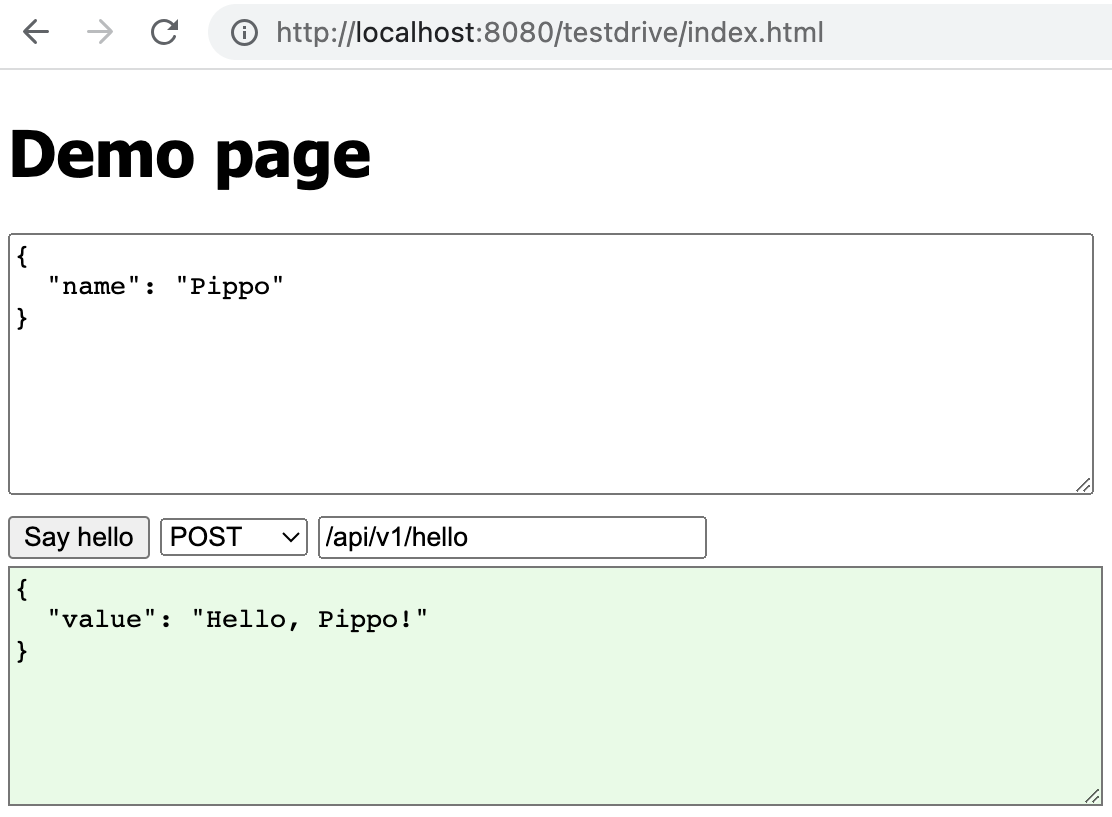
Determine 2: The person can tweak the request payload, approach and trail: the reaction seems within the decrease window,
coloured inexperienced to indicate a a hit reaction
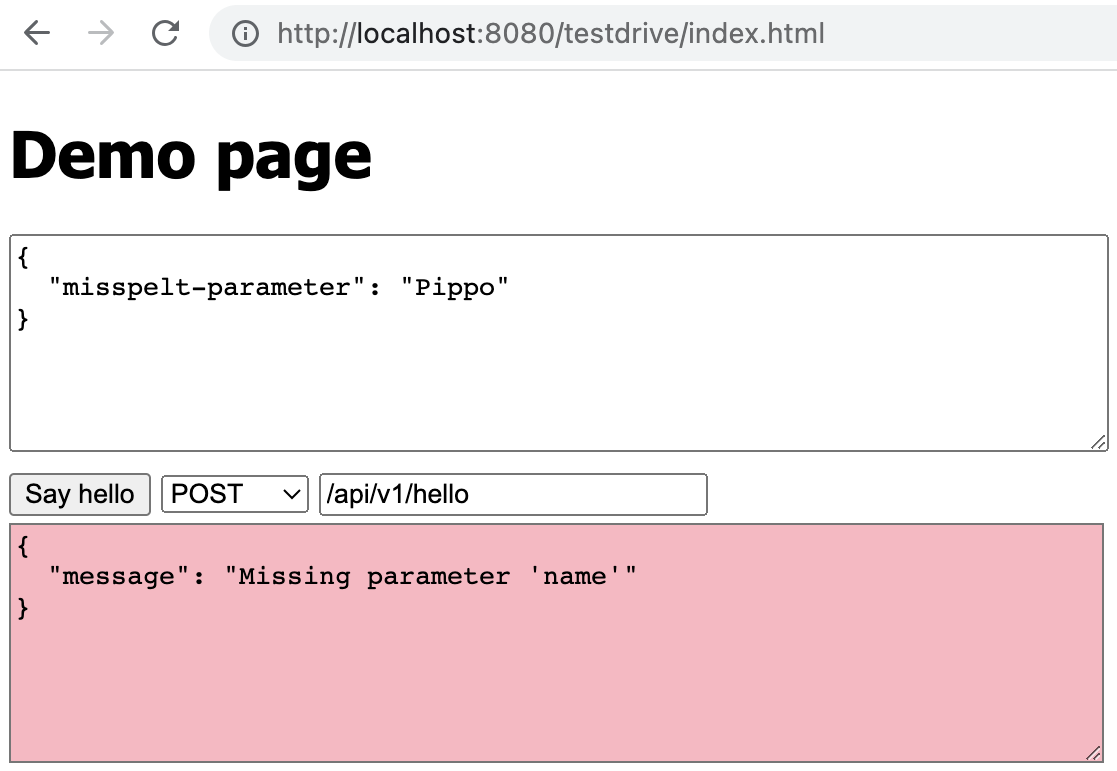
Determine 3: Error responses are made extra obtrusive by way of coloring the
output textual content space purple
The demo UI prepares a legitimate JSON request for a given API endpoint, then it
shall we the person regulate the request by way of hand to fit what they wish to check, and
when the person presses the button, it’s going to show the reaction, in all probability alongside
with the http standing code and any related headers.
Even supposing at this level we are nonetheless appearing JSON as each enter and
output, we have now a substantial merit over Postman, in that we will be able to use
automation to enhance or regulate a static model of the enter JSON this is
proposed to the person. If, for example, a legitimate request will have to include a
distinctive identifier, a brief snippet of JavaScript can generate a random
identifier with out a effort required at the a part of the person. What is vital right here
is that the UI lets in a snappy check with minimum friction.
The JavaScript required for creating a Demo Entrance-Finish equivalent to this one is
minimum: present JavaScript is robust sufficient without having for explicit
libraries, despite the fact that builders would possibly to find it to hand to make use of light-weight gear such
as htmx, jQuery and even inline React. We advise to steer clear of putting in a
devoted construct, as this introduces additional steps between working the API and
executing a check throughout the UI. Preferably, the one construct we might love to run is
the construct of the API product itself. Any lengthen between the need to check
one thing and the instant we’re in reality executing the check slows down the
construction loop.
The herbal evolution of the sort of UI is to
- Upload amenities to generate various kinds of enter; most likely change
utterly the JSON textarea with a right kind HTML shape - Parse and display the output in some way that is clean to grasp
For example, assume we have now a travel-related API that permits us to e book
flights, with the aim to search out the most efficient offers for travellers who will also be
versatile at the date. We would possibly have an preliminary API that plays a seek and
returns a listing of costs mixtures. The enter JSON would possibly seem like
{
"departure-airport": "LIN",
"arrival-airport" : "FCO",
"departure-date" : "2023-09-01",
"return-date" : "2023-09-10",
"adults" : 1,
"kids" : 0,
"babies" : 0,
"foreign money" : "EUR"
}
Our demo UI will load within the enter textual content space a pattern payload, thus sparing
the person from having to keep in mind the right syntax.
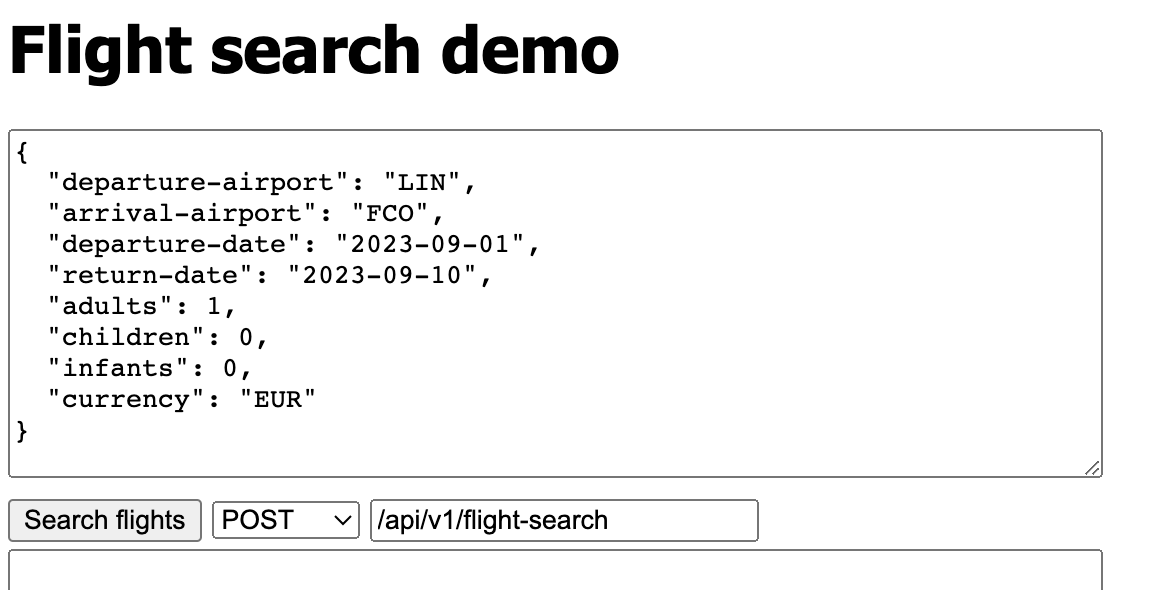
Determine 4: Actual JSON payloads have a tendency to be sophisticated
Then again customers would possibly wish to alternate the dates, as a result of any static departure
or arrival date will sooner or later grow to be invalid as time passes and the dates
grow to be previous, and converting the dates takes time, and may end up in additional time
misplaced on account of handbook mistakes. One resolution might be to routinely regulate
the dates within the JSON, environment them to, say, 30 days sooner or later. This is able to
make it really easy to accomplish a snappy “smoke check” of the API: simply click on
“Seek flights” and spot the consequences.
Shall we take this a step additional: for example, once in a while we would possibly wish to
take a look at the costs of flights kind of six months sooner or later; once in a while 3
months, and once in a while only one week upfront. It’s cool to supply a UI
that permits the person to temporarily alternate the JSON payload by way of settling on from
drop-down menus. If we give you the similar for different enter fields, for example
the airport codes, we take away the desire for the person to appear up airport codes,
which additionally takes treasured time.
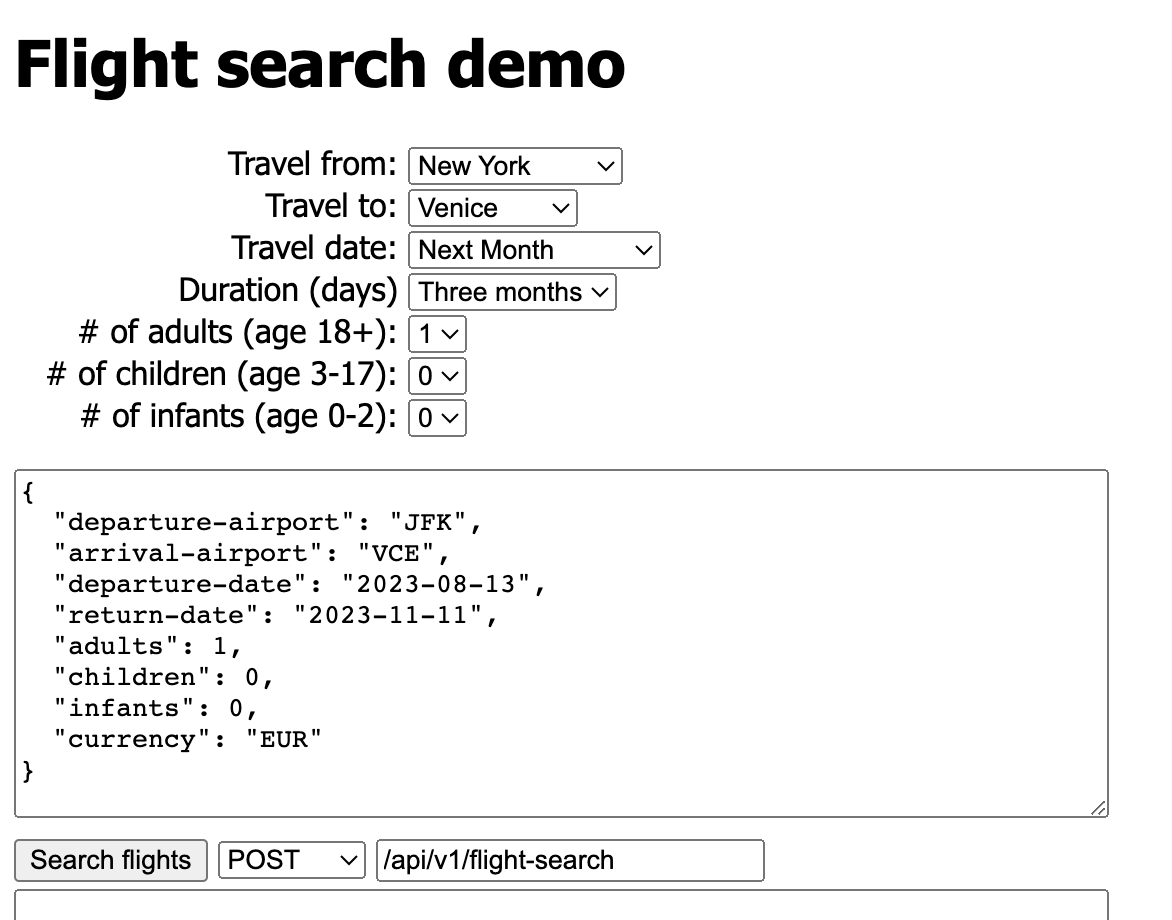
Determine 5: Including an HTML shape to tweak the payload
routinely
The above UI makes it fast and clean to switch the JSON payload, requiring
little or no experience from the a part of the person. It’s nonetheless conceivable to
check up on the generated JSON, and the person can alternate it immediately, if they would like
to check a case that’s not lined by way of the HTML shape.
The flights seek API may go back a matrix of costs various by way of date,
that permits a buyer to select the most efficient aggregate of departure and go back
flights. As an example:
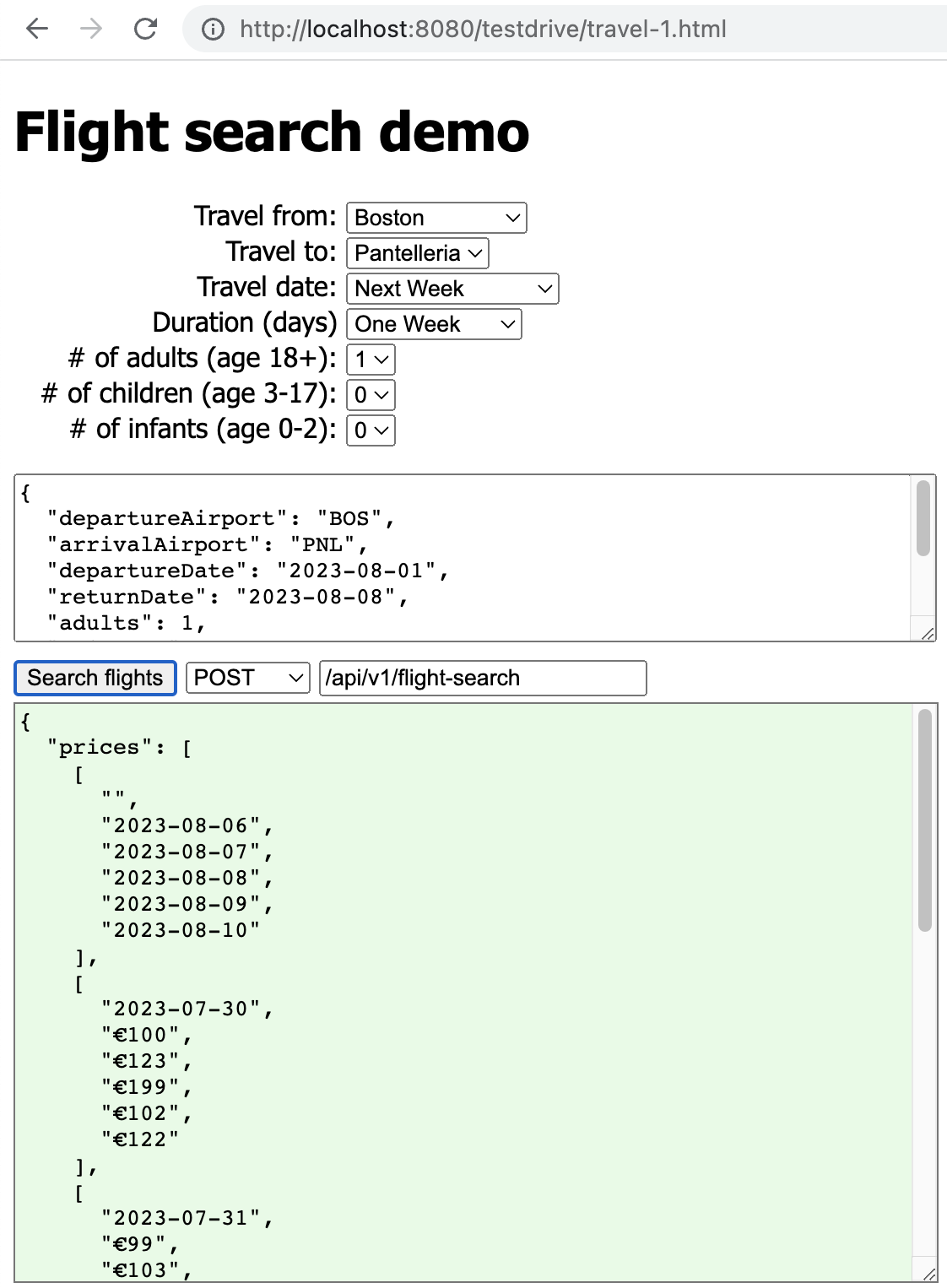
Determine 6: JSON responses have a tendency to be sophisticated too
It’s tricky for people to make sense of the fee matrix in JSON, so we
can parse the JSON and layout it in a pleasing HTML desk.

Determine 7: Parsing the reaction and presenting it
in an easy-to learn layout
A easy HTML desk can move an extended approach to make it clean for technical and
non-technical customers to make sure the result of the API.
Commonplace questions
Why no longer use Swagger UI as an alternative?
Swagger UI satisfies probably the most similar just right qualities because the Demo Entrance-Finish:
it may be made instantly to be had,
it’s outlined in the similar supply code repository because the supply code;
it’s served from the similar carrier that serves the API.
It does have some drawbacks, in comparison to the Demo Entrance-Finish:
- The enter and output payloads in Swagger UI are restricted to JSON: you can’t make it extra readable.
- It is not pleasant to non-technical customers.
- It may well simplest serve static payloads; what if you want to supply a random identification at each invocation?
What if the payload will have to include the present date? The person will have to keep in mind repair the payload by way of hand,
they usually wish to know the way to mend it. With a little of JavaScript, you’ll be able to simply supply this
routinely within the Demo Entrance-Finish - Swagger UI does no longer reinforce workflows; with a Demo Entrance-Finish,
you’ll be able to information the person by way of presenting in the right kind order the calls to be made.
You’ll additionally take portions from the output of 1 name, and use them to organize the payload for the following name in a workflow
Must we arrange a devoted construct with npm?
In case your Entrance-Finish makes use of a devoted construct command, then you will have an additional step on your
native edit-compile-run-test loop: this makes your loop slower. It additionally calls for you
to complicate your Steady Integration and supply automation: now your supply code repository
produces two artifacts as an alternative of 1; you need to construct each and deploy each.
For those causes, I do not suggest it. If you’re used to “giant” Entrance-Finish frameworks
equivalent to Angular, you could be shocked at how a lot will also be performed simply by loading
jQuery or React in an inline <script> tag.
Are not we doing paintings that the customer didn’t ask for?
The Demo Entrance-Finish improves some cross-functional houses of the product, that
the customer is more likely to recognize: on the very least, the testability of the
product and the developer revel in, therefore the velocity of construction, however there
are different cross-functional houses that could be usefully impacted.
Let me inform you a tale: some time again, we have been engaged within the rewrite of an API product.
In that product, an API calls may lead to tens of calls to different downstream products and services,
and each and every of the ones downstream name may fail within the HTTP sense, by way of returning an HTTP error standing code, and may fail logically, by way of returning a logical error code within the reaction payload.
For the reason that any of the ones tens of downstream calls failing in numerous tactics may
lead to a distinct, surprising lead to our API reaction, it was once transparent that we wanted
a approach to temporarily see what took place when our device interacted with downstream products and services, so
we enhanced the Demo Entrance-Finish with a document of all downstream products and services interplay, appearing the request and reaction from each and every downstream name based on one name to our API.
The Demo Entrance-Finish sooner or later become a killer characteristic that contributed very much to the luck of the product, as it allowed testers to debug simply why a decision did not produce the anticipated outcome. The Demo Entrance-Finish was once sooner or later made to be had in manufacturing too, in order that interior customers may troubleshoot calls coming from the product purchasers, i.e., their companions. The customer instructed us they have been glad as a result of they might now troubleshoot in mins why a decision did not paintings as anticipated, in comparison to days within the earlier device.
The customer didn’t explicitly ask for a Demo Entrance-Finish, however that they had instructed us all the way through the undertaking inception, how tricky it was once for them
to troubleshoot why some calls to the API have been returning surprising values, the usage of their present device.
The Demo Entrance-Finish we constructed for them was once, amongst different issues, a technique to an issue
that they instructed us that they had.
Going additional
APIs endpoints are frequently intended for use in succession, to reinforce some
more or less automatic workflow, or most likely a choice procedure at the a part of a
human person. In those circumstances, we would possibly lengthen the Demo Entrance-Finish to explicitly
reinforce the workflow. In some way, the Demo Entrance-Finish can be utilized as documentation
for API customers on how one can use the API, or as a prototype frontend to be taken as
an instance for a complete implementation.
There may be some pattern code that can be utilized as a place to begin on this
git repository; the screenshot have been taken from it.

